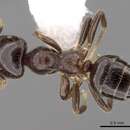en
names in breadcrumbs


Prior to Longino (2006) M. cooperi was known only from the holotype queen, taken with no associated biological data near Turrialba. I rediscovered the species in the Pe–as Blancas Valley, east of Monteverde in the Cordillera de Tilar‡n. The habitat was mature wet forest at 800m elevation. I found nests in live stems of a small lauraceous tree. A voucher specimen of this tree was obtained (William Haber collection #10708) but it has not been identified. At this field site O. dendrodaphne and atirrensis were common in the understory, inhabited by M. flavocotea and M. nigrocotea. The tree species inhabited by M. cooperi was distinctly larger than these and much less common. I found several trees and they all contained M. cooperi in the live stems. One of the branches contained alate queens and males in addition to workers. One of the branches contained a dealate queen and workers.
Costa Rica (type locality). Costa Rica: mid-elevation Atlantic slope.
Taxonomic history
Longino, 2006a PDF: 14 (w.m.).Combination in Aphomomyrmex: Gregg, 1954a PDF: 104.Combination in Neaphomus: Kempf, 1972b PDF: 152.Combination in Myrmelachista: Snelling & Hunt, 1975 PDF: 110.Figure 10
Camponotus (Myrmostenus) cooperi Gregg 1951:80. Holotype queen: Costa Rica , Turrialba ( Cooper ) .
Aphomomyrmex (Neaphomus) cooperi : Gregg 1954:102.
Neaphomus cooperi : Kempf 1972:152.
Myrmelachista cooperi : Snelling and Hunt 1975:110.
Diagnosis
Worker antenna 9-segmented; maxillary palpus 6-segmented; color black. Queen black, antenna 10-segmented, head elongate and strongly flattened, mandible falcate.
Worker (previously unknown)
Antenna 9-segmented; maxillary palpus 6-segmented; mandible with teeth 4 and 5 (counting from apex) separated by a wide diastema, teeth 1-4 more closely and evenly spaced; dorsal surface of mandible striatopunctate near masticatory margin, grading to smooth and shining basally; clypeus strongly bulging medially, some workers with longitudinal median carina; face with superficial reticulate sculpture, becoming denser on clypeus and anterior malar spaces; in full face view, with abundant short erect setae projecting from rear margin of head, absent from sides of head; ventral surface of head with short sparse appressed pubescence, no erect setae; scapes with abundant erect to subdecumbent setae, longer setae subequal to width of scape; HW of large worker 0.76mm; outer surface of hind tibia with abundant erect setae, longer setae about 2/3 width of tibia; color black.
Measurements: HL 0.761-0.881, HW 0.750-0.853, SL 0.398-0.457, EL 0.157-0.178, CI 94-100 (n=3).
Queen
Antenna 10-segmented; maxillary palpus 6-segmented; labrum a large shiny plate that completely covers and closes the buccal cavity and other mouthparts (in other Myrmelachista the labrum is shorter, not covering the buccal cavity); mandible falcate, with three apical teeth and a series of small denticles; dorsal surface of mandible striatopunctate near apex, grading to smooth and shining basally; clypeus with large conelike projection; face smooth and shining; in full face view, with abundant erect setae projecting from rear margin of head, much shorter erect setae on sides of head; ventral surface of head with long suberect pubescence; scapes with abundant erect to subdecumbent setae, longer setae subequal to width of scape; outer surface of hind tibia with abundant erect setae, longer setae about 2/3 width of tibia; petiole elongate, with very long, low node; color black. See also description of Gregg (1950).
Measurements: HL 1.684, HW 1.123, SL 0.613, EL 0.330, OW 0.081, OD 0.251, CI 67, OI 29, OcI 5 (n=1).
Male (previously unknown)
Antenna 11-segmented; maxillary palpus 6-segmented; pygostyles present, sclerotized, setose; basiparamere lobe and paramere short, robust, broadly triangular; cuspis robust, spatulate, with an apicodorsal field of small teeth at the apical contact point with the digitus; digitus short, dorsal margin forming an abrupt right angle, apex of digitus a ventrally directed triangular lobe; penial valve short and broad, apex blunt, with dorsally-directed short triangular tooth, apodeme of penial valve strongly developed, at right angle to the rest of valve.
Range
Costa Rica. In Costa Rica it is known from two mid-elevation sites on the Atlantic slope.
Biology
Prior to this study M. cooperi was known only from the holotype queen, taken with no associated biological data near Turrialba. I rediscovered the species in the Peñas Blancas Valley, east of Monteverde in the Cordillera de Tilarán . The habitat was mature wet forest at 800m elevation. I found nests in live stems of a small lauraceous tree. A voucher specimen of this tree was obtained (William Haber collection #10708) but it has not been identified. At this field site O. dendrodaphne and atirrensis were common in the understory, inhabited by M. flavocotea and M. nigrocotea (see below). The tree species inhabited by M. cooperi was distinctly larger than these and much less common. I found several trees and they all contained M. cooperi in the live stems. One of the branches contained alate queens and males in addition to workers. One of the branches contained a dealate queen and workers.
Comments
The strongly falcate mandibles, the enlarged labrum covering the mouthparts, the shiny surface, and the diminutive thorax and abdomen in relation to the head are similar to other species known to be temporary social parasites (the parasite syndrome, see Hölldobler & Wilson 1990). The suite of characters suggests that queens of cooperi may use some form of social parasitism to establish colonies.
This is the only Myrmelachista species I know in which the workers and queens differ in number of antennal segments: workers with 9 and queens with 10 (based on examination of three queens and dozens of workers). The male genitalia are very similar to zeledoni , and very different from any of the other species with 9-segmented antenna. This suggests that cooperi is derived from a zeledoni-like ancestor, the 9-segmented antennal count in the workers may be independently derived relative to other 9-segmented species, and it may not be particularly closely related to the other Lauraceae-inhabiting species.
Material examined
COSTA RICA , Alajuela : Refugio Eladio, Rio Peñas Blancas , 10°19’N , 84°43’W , 800m ( J. Longino , 4 collections)